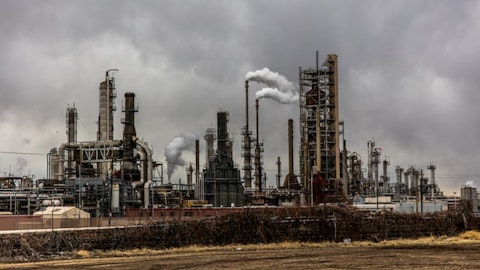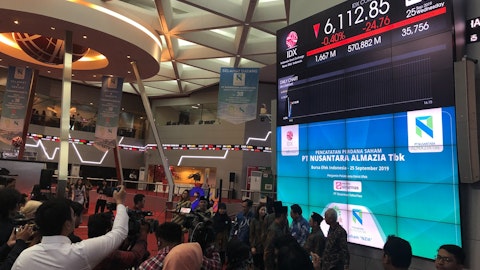Doug Leggate: No, that’s great color. Thanks. Thanks Matt. My follow-up is, I guess it’s a regulatory question. Halfway through the quarter, Governor Newsom made some changes to RVP standards, or timing rather, in California. And I’m just wondering, when you saw the strength of cracks in the first half of the quarter and obviously attracted some kind of regulatory response. What was your thinking and all the noise around how that might play out with the commission and so on, assuming volatility in the West Coast has also moved to a new level, given the pending closure of Rodeo?
Matthew Lucey: Yes. So, interesting, on the butane, I actually think it was a smart thing to do and it increased supply. The problem we have with much of the regulatory framework when they see problems with price, they don’t address the core issue. So, advancing the butane blending by a couple of weeks, increased supply of gasoline, and we saw a precipitous drop in margins, which was fine. It was probably a prudent thing to do for the people of California. Again, the issue is many of the steps that, or most of the steps, if not all the steps besides that, have unintended consequences that usually exasperate the problem, which could be limiting supply. So, it was not a surprise to us. We’ve seen regions do that when there are – when there is tightness in the market. I don’t know what will happen in the future, but that’s always sort of an arrow that can be pulled. But we continue to recognize California as a very, very tight market and about to get tighter.
Doug Leggate: Yes. We’re watching with interest. Thanks so much, Matt. Appreciate the comments.
Operator: Thank you. Our next question comes from the line of Ryan Todd with Piper Sandler. Please proceed with your question.
Ryan Todd: Thanks. Congratulations on a great quarter, guys. And maybe, Matt, if I could follow up, and thanks for your comments on the corporate and balance sheet priorities? I mean, I think with the balance sheet reductions complete, the J. Aron facility retired, like you said, and RIN liabilities retired or reduced significantly, can you talk about cash priorities from here? Should we expect to see a greater share of free cash flow targeted for share buybacks going forward? Or are there other things that we should be – other than the hydrogen projects that we should be considering?
Matthew Lucey: Well, look, we’ve chopped a lot of wood reducing leverage for the company over the last year. But as I sit here today, as we sit here today, it’s complete. There’s nothing left to address. We’ve got our bonds done. Karen and her team did a great job extending our bond maturities. We reduced it a little bit. We’ve got $1.3 billion of bonds outstanding, and we have no interest in reducing it further. As you said, the RINs have been put to bed, Intermediation Agreements have been paid off. So there is no more balance sheet work to be done, and it’s a pretty amazing moment that we should all sort of take and recognize. So, going forward, as we generate excess cash, we’ll look to deploy it the best way we can. There are no major project on our books that we’re reserving for at the moment.
We’re actively looking for opportunities for us to explore and bring to the market. But as of the moment, we have a very, very clean balance sheet, no work to be done. So as we generate cash, we’ll look to reward shareholders.
Ryan Todd: Thank you. That’s great. And then maybe just to follow-up on the CapEx increase that you talked about. It sounds like you may have pulled forward a little bit of the long lead time items for the 2024 turnaround cost into the 2023 budget there. With RD spend now complete, I mean, as you said, no major projects on the books going forward, can you maybe walk through how we should think about the run rate for CapEx for the business going forward, in particular, as we look into 2024?
Matthew Lucey: Yes. I mean, the simple answer is, it’s not going down. I mean, there’s cost pressures and that’s our job to manage. We haven’t put out CapEx guidance for next year yet. I think that’s usually maybe on the next call. But I don’t think someone should be saying that there’s going to be a step down. It’s our job to manage it, so it’s not a step up.
Ryan Todd: Okay. Thank you.
Operator: Thank you. Our next question comes from the line of Manav Gupta with UBS. Please proceed with your question.
Manav Gupta: Good morning, guys. I’m hoping you can give me some more macro commentary on the regional gasoline markets. You operate in all regions. Where are you seeing strength in gasoline relatively and where there is some weakness? And also, are you actually seeing any kind of red flags in terms of demand, which should worry us? I mean, the gasoline crack went to mid-single-digits. It has rebounded, but it’s still lower. So is it just seasonal or do you think there is something structural to worry about? If you could talk about those points?
Matthew Lucey: So, I’ll start with the first part and then pass it over to Paul on the specific region. In regards to demand, I think what you’re going to hear from us is consistent with what you’ve heard from others. It’s been stable and we’ve had no problem moving products through our system. We’ve had no decline in our wholesale business. And so – I was struck by sort of the monthly data that came out the other day that sort of corroborated that. I mean, you have weekly swings, ins and outs, and that’s a bouncing ball that can be hard to follow. But when you pull back a little bit, I think maybe you get a little bit better picture. So, the demand, I think, has been okay. Obviously, we’ve hit the shoulder season as we always do, and you see seasonal differences. But Paul, do you want to run through regions?
Paul Davis: Yes. From a regional standpoint, obviously, the coastal markets have been and are still the strongest markets. West Coast primarily is our strongest market that we see from a demand standpoint, obviously, for value too. East Coast is right there, though. East Coast has been very strong through this year, certainly through the third quarter, and even as we speak today. Weakest, coming out of the third quarter I’d say PADD 2 was the weakest, and that’s what we saw in our circuit. But that’s migrated down to the Gulf. And right now, I would say the Gulf Coast is the weakest market, both from value and overall demand.
Manav Gupta: Perfect. I have a quick follow-up. Your press release says your outstanding environmental credit payables were reduced by $340 million. I’m just trying to understand, did you actually pay $340 million or the RIN prices and stuff came down a little and then you paid? And also, I think in the opening comments, you mentioned the RIN revaluation benefit of $100 million, if you could confirm that? Thank you.
Karen Davis: Yes, I’ll take that question. Yes, there was a $99 million mark-to-market benefit that’s included in our gross margin. And with respect to cash outlay for reducing environmental credits, yes, the amount that we provided was the cash outlay.
Manav Gupta: Thank you.
Operator: Thank you. Our next question comes from the line of Matthew Blair with Tudor, Pickering, Holt. Please proceed with your question.
Matthew Blair: Hi, good morning. Thanks for taking my questions. I wanted to follow up on this MACH2 hydrogen hub. Is your opportunity impacted at all by the hydrogen deal that you did with Air Products in 2020? And do you have any early thoughts on CapEx or the EBITDA opportunity here?
Matthew Lucey: First answer is, no, in regards to the Air Products deal. In regards to capital, it is too early to get into that. We’re going to spend the next 12 to 18 months working with the consortium and developing a detailed plan. Once we get to that point, that could include PBF looking to participate in regards to contributing capital to the project. It could also include PBF bringing in a partner if the returns don’t meet our expectations to do that. But there’s no question that MACH2 project extends benefits and positive impacts to PBF. Obviously, there’s a potential for a capital project. That capital project, as I said, will need to be competitive from a return standpoint, but it also – and by the way, I would describe PBS participation in this as the anchor within MACH2 and I don’t say that lightly.



